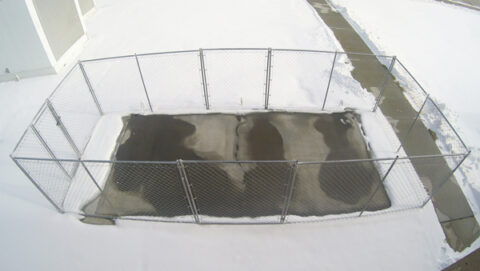When the snow starts to fall, airports rely on chemical deicers to give their passengers a safe flight and keep airline traffic moving. But deicers have a dark side. The substances, which can both harm aquatic organisms and spur bacterial growth, trickle into local waterways and seep into groundwater. One solution might be an innovative form of concrete that heats airport tarmacs from within—no chemicals needed.
Road salt is too corrosive to use near planes, so airports rely on glycol-based compounds to remove ice from airplanes and pavement deicers made from potassium formate, sodium acetate, sodium formate, or, most commonly, potassium acetate to clear the tarmac and runways. Until the late 1990s airports mainly used urea for deicing, but when scientists discovered that it was polluting streams with ammonia, most facilities made the switch to potassium acetate.
“The move to potassium acetate was an interesting one because we all knew that urea wasn’t a great idea to be spreading and getting into the streams because of the toxicity from ammonia,” said Steve Corsi, a research hydrologist at the U.S. Geological Survey in Middleton, Wis. “But there really wasn’t much data from potassium acetate. It turns out that potassium acetate has its own toxicity problems.”
Testing and Containing Deicers
Corsi and his team are collaborating with the General Mitchell International Airport in Milwaukee, Wis., to conduct an ongoing study of the environmental effects of airport deicers. Their research found that pavement deicers running off the airport’s tarmacs and runways contained 10 times the concentrations needed to kill some organisms, such as minnows and water fleas. Another study showed that the pavement and airplane deicers flowing together into nearby streams could trigger population booms for other organisms, such as certain bacteria and algae. The microbial population booms can lower the concentration of dissolved oxygen in the water to dangerous levels for other aquatic life.
When it comes to sprawling airport runways and tarmacs, deicer runoff has proven difficult to contain.
Airports use deicing pads to collect drainage from aircraft deicers, saving it in storage tanks and ultimately recycling it or sending the waste to a treatment plant. But when it comes to sprawling airport runways and tarmacs, deicer runoff has proven far more difficult to contain. Recovery vehicles with powerful vacuums sweep the pavement like Zambonis, vacuuming up as much deicer as possible, but they can never act in time to catch all of the deicer-laced water before some of it finds unpaved ground to soak into, said Corsi. Airport personnel often inflate balloon-like storm sewer plugs to keep unwanted chemical runoff out of sewers during deicing periods, but these are useless against fluids absorbed directly into the ground.
“It becomes this balance between human safety and environmental concerns,” said Corsi. “All the airports are trying to contain [deicer runoff] as much as they can at this point.”
A Concrete Alternative

One solution might be to ditch the pavement deicers altogether. Chris Tuan, a professor of civil engineering at the University of Nebraska–Lincoln, has been working since the mid-1990s to develop an affordable concrete that can conduct electricity. Regular concrete is not conductive and easily accumulates snow and ice, but Tuan’s conductive concrete is sprinkled with steel shavings and carbon particles, and it is embedded with long steel rods that can be connected to a power source to heat the material. The idea is to activate the concrete several hours before a storm hits, so by the time flakes begin to fall they melt the moment they hit the surface.
“It’s been through several generations,” said Tuan. “Now we’re using carbon particles, steel shavings, and steel fibers. This design keeps evolving, and we’re trying to reduce the cost.” Although its material cost—more than twice that of regular concrete—still makes the concrete impractical for paving large surfaces like entire roadways, it costs only about 2 cents per square foot (22 cents per square meter) to heat it. The conductive concrete has already been used to pave a parking garage in China and a bridge in Nebraska.
The Federal Aviation Administration (FAA) is currently considering using the conductive concrete in airports but only for tarmacs rather than runways because of expense. The agency is working with Tuan to test the concrete’s capabilities as a tarmac pavement. This joint project, which will extend through the end of March, is investigating whether the concrete offers adequate mechanical strength and long-term durability to meet airport demands. If all goes well, the FAA will perform a full-scale tarmac construction using the concrete at its technical center in Atlantic City, N.J., later this year. “So far the performance is pretty good, so we’re very excited,” said Tuan.
—Shannon Kelleher, Writer Intern
Citation: Kelleher, S. (2016), Electrical concrete offers green alternative to airport deicers, Eos, 97, doi:10.1029/2016EO044999. Published on 29 January 2016.
Text © 2016. The authors. CC BY-NC 3.0
Except where otherwise noted, images are subject to copyright. Any reuse without express permission from the copyright owner is prohibited.

